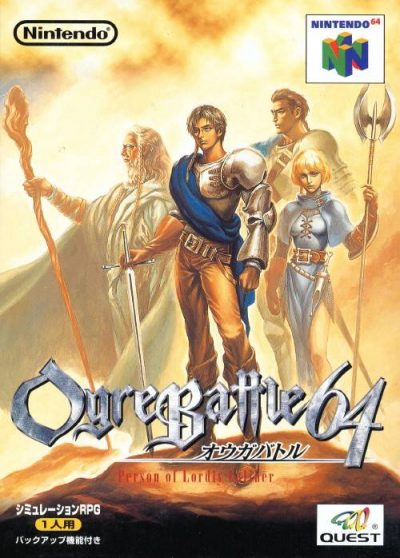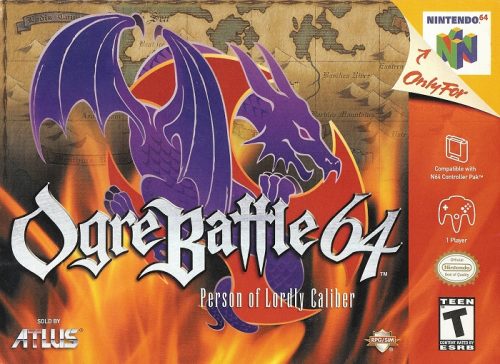Ogre Battle 64: Person of Lordly Caliber
So, the semester is well underway, you have a heavy load of coursework to do, a full time job, a blog you need to update, a woman you’re attempting to woo, a library to volunteer at, all in addition to the normal errands and chores and unforeseen tasks to do. It’s a lot, so how do you deal with so much work? Obviously, you dive into the sprawling 40+ hour campaign of Ogre Battle 64: Person of the Lordly Caliber, the best game of its era and, for me, the best of any era - with one massive, almost game-wrecking caveat, which we’ll get to shortly.
I’ve touched on the _Ogre Battle _franchise a couple times previously in talking about the two Tactics Ogre spin-off games, Let Us Cling Together and The Knight of Lodis. In those reviews, though, I mentioned that I preferred the gameplay of the main series. It’s an RPG/Strategy hybrid, where the player forms units of highly customisable characters and in each stage uses them to capture strongholds and beat an enemy boss character, then repeat the process in the next stage. The overall flow of each mission isn’t terribly different from many strategy games, but what makes it interesting is the interaction between two levels of army customisation in the characters and units they’re part of. There are a few dozen character classes to choose from, each of which can equip different items and grow in experience like most RPGs, but in addition to this one must consider how each character complements others in the same unit, and how those combinations fare against different enemy formations. Though it is possible to build just a few super-units and overpower everything, it is, of course, most satisfying to play the intended way, and the mechanics give the game a lot of replay value despite its length (my last play-through took about forty-three hours, without doing much in the way of side-quests).

Box cover for the Japanese release
One thing Ogre Battle is known for is its alignment system, which uses a lawful/chaotic axis much like Dungeons & Dragons. A character’s alignment can raise or lower depending on the alignment of other characters in the same unit, but is mostly manipulated by having characters defeat significantly stronger enemies to raise alignment (or weaker characters to lower it) and defeating chaotic-aligned enemies to raise alignment/lawful enemies to lower it. I found lowering alignment a bit difficult since enemy strength naturally rises from mission to mission, but overall it’s not too hard to manipulate alignment over the long run. As you might guess, alignment affects which classes characters can become, and can also affect your reputation metre.
Oh, and about the reputation metre (which is actually given the meaningless name “chaos frame” in OB64). If you’ve played the Super NES original, you surely remember this. Based on your actions, your reputation can go up or down, and that in turn determined which special characters you can recruit and which ending you get. Well, that reputation metre exists here, too, but it’s hidden. Not only is it hidden, but neither the manual nor the game itself say anything about it, even in the tutorial or in the extensive help menus. When I first played this game back in middle school, I remember playing through thinking I was doing everything right, but was concerned that I couldn’t seem to recruit many special characters. After about forty hours or so, I finally beat the game, only to basically have it tell me I suck. Baffled, I went onto GameFAQs, and there I finally figured out what just happened to me. It was one of the most frustrating experiences I’ve ever had with a game, and it was a couple years before I replayed it and, now that I knew what the heck I was supposed to do, got the best ending.
The original Ogre Battle was also somewhat opaque on how reputation worked, but since you could see the metre you could at least get a general sense of how you were doing and what made it go up or down. Hiding that metre, even once you know it’s there at all, adds needless frustration to a game that can already be a handful for new players. The situation is tolerable if you’re playing with a guide that explains this stuff to you, but it’s always annoying and a very strange decision in a game that otherwise goes out of its way to help players understand the game mechanics.
Speaking of the mechanics, Ogre Battle can seem intimidating to those who don’t play strategy games often, but again, the tutorial and in-game help is very good. If you’re the type of person who plays a lot of, say, Paradox Interactive games it’ll even seem simple. For me, the complexity is about perfect, but the overall challenge is a bit on the easy side once you know what you’re doing. Some missions are a bit tricky and the final boss takes some careful planning, but rarely did I have to try a mission more than once. That said, I did struggle more when I first played this years ago, so perhaps it just seems easy due to previous experience.
When I reviewed Mischief Makers, I said that I put very little value on story in video games. Nonetheless, a good story is nice to have and is one of Ogre Battle 64’s strengths. Though it starts as a basic “good revolution vs. bad empire” plot, as the story develops it does add some depth and gradually shifts the focus to more interesting stuff with ultimate powers and resurrecting goddesses and such. The endings I’ve seen are all good, though unfortunately a little flat. My only complaint is that most of the special characters get no real development beyond the mission you recruit them in. You do get additional scenes during the two better endings (though not in the one bad ending) depending on who you recruited, but they really add nothing of substance to either the ending or even to what we know about the characters themselves. For those wondering about the endings, there are three basic endings you can see, each with additional scenes for special characters you recruited. All three are based on your reputation.
I must also mention that the aesthetic of the game is extremely good. The character designs are great, the music excellent, and the background art good; character models are a bit stiff, but it’s not too bad. Like the original game, character portraits used in dialogue have a traditional, realistic style to them, while the character models are cartoonier. I’m ambivalent about that. The models look good and keep the game from feeling overly serious, as it might otherwise, but they also feel somewhat out of place in such an in-depth game with a serious plot.

The American cover is totally different, but also very good
Besides all that, Ogre Battle 64 holds a lot of nostalgic value for me. I remember reading about the original game in Nintendo Power, but as a niche game it wasn’t easily available and these days can only be found at high prices. I did see and feel excited at the announcement for Tactics Ogre, but that turned out to be Japan-exclusive and wouldn’t see an American release until the PlayStation remake. So when it was officially announced that OB64 would have an American release, I was there right away and had my parents take me to the local game shop, allowance savings ready, very shortly after it came out. I’ve never anticipated a game like that before or since, and it completely lived up to my expectations (well, until the end, that is). Today, it’s not difficult to find a copy online - but be ready to pay top dollar for it. Even at high prices it’s worth buying for the amount of content you get, but I also won’t throw stones at those who go for alternate avenues to play.
If this franchise is ever resurrected, I’ll be all over it. For that matter, I’d be interested in seeing a re-release of this game, as well, if it includes a few touch-ups. Improve the graphics and character models a bit, maybe add a little content here and there, and most of all - show us the damn reputation metre. Please.